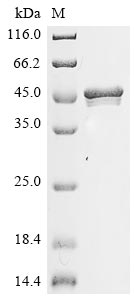Recombinant Paeniclostridium sordellii Sialidase is produced in E. coli and includes the complete mature protein sequence from amino acids 28 to 404. The protein comes with dual tags—an N-terminal 10xHis-tag and a C-terminal Myc-tag—which makes it useful for different research applications. SDS-PAGE analysis shows the purity is over 90%, suggesting it's appropriate for detailed biochemical work. This protein is meant for research purposes only.
Sialidase from Paeniclostridium sordellii appears to be an enzyme that cleaves sialic acids from glycoproteins and glycolipids. These enzymes have become important tools for studying how cells interact with each other, signal transduction pathways, and bacterial disease mechanisms. This particular enzyme is likely to be valuable for researchers working on carbohydrate metabolism and microbial virulence. It may offer insights into how bacteria cause infections and interact with their hosts.
Potential Applications
Note: The applications listed below are based on what we know about this protein's biological functions, published research, and experience from experts in the field. However, we haven't fully tested all of these applications ourselves yet. We'd recommend running some preliminary tests first to make sure they work for your specific research goals.
Paeniclostridium sordellii Sialidase is a bacterial enzyme that requires precise folding, proper active site formation, and specific tertiary structure for its catalytic activity in cleaving sialic acids. The E. coli expression system is homologous to this bacterial protein, which increases the probability of correct folding. The dual N-terminal 10xHis-tag and C-terminal Myc-tag are relatively small (∼1 kDa and ∼1.2 kDa, respectively) compared to the protein size (28-404aa, ∼40 kDa), causing minimal steric interference. While the full-length mature protein contains all functional domains, the probability of correct folding with functional sialidase activity requires experimental validation of enzymatic activity.
1. Biochemical Characterization of Bacterial Sialidase Activity
This application carries a significant risk without functional validation. Sialidase activity requires precise active site formation and proper folding. If correctly folded and active (verified through enzymatic assays with sialylated substrates), the protein is suitable for kinetic studies (Km, Vmax). If misfolded/inactive (unverified), biochemical characterizations will yield biologically meaningless results.
2. Comparative Enzyme Studies and Phylogenetic Analysis
Meaningful comparative studies require native enzyme conformation and functional activity. If correctly folded and active (verified), the protein enables valid evolutionary comparisons of sialidase properties across species. If misfolded/inactive (unverified), comparative analyses would yield misleading insights about enzyme conservation and divergence.
3. Antibody Development and Immunological Studies
This application is highly suitable as antibody development relies on antigenic sequence recognition rather than functional enzymatic activity. The full-length protein provides comprehensive epitope coverage for generating sialidase-specific antibodies. The high purity (>90%) ensures minimal contamination-related issues.
4. Protein-Protein Interaction Studies
This application requires proper folding validation. Sialidase interactions with substrates or host proteins require precise tertiary structure. If correctly folded (verified), the protein may identify physiological interaction partners; if misfolded/unverified, there is a high risk of non-specific binding or tag-mediated artefacts.
5. Glycobiology Research and Substrate Development
This application carries a high risk without functional validation. Substrate modification requires an active enzyme with the correct specificity. If correctly folded and active (verified), the protein is suitable for glycobiology applications; if misfolded/inactive (unverified), it will not function and may yield erroneous results.
Final Recommendation & Action Plan
The E. coli-expressed sialidase with small dual tags has a high probability of correct folding due to the homologous expression system, but experimental validation of enzymatic activity is crucial. Begin with functional validation using standard sialidase assays (e.g., with sialylated substrates like fetuin or synthetic analogs) to confirm specific activity. Applications 1, 2, 4, and 5 require this validation before proceeding. Application 3 (antibody development) can proceed immediately. For reliable sialidase research, always include positive controls and validate key findings with activity assays to ensure biological relevance.






